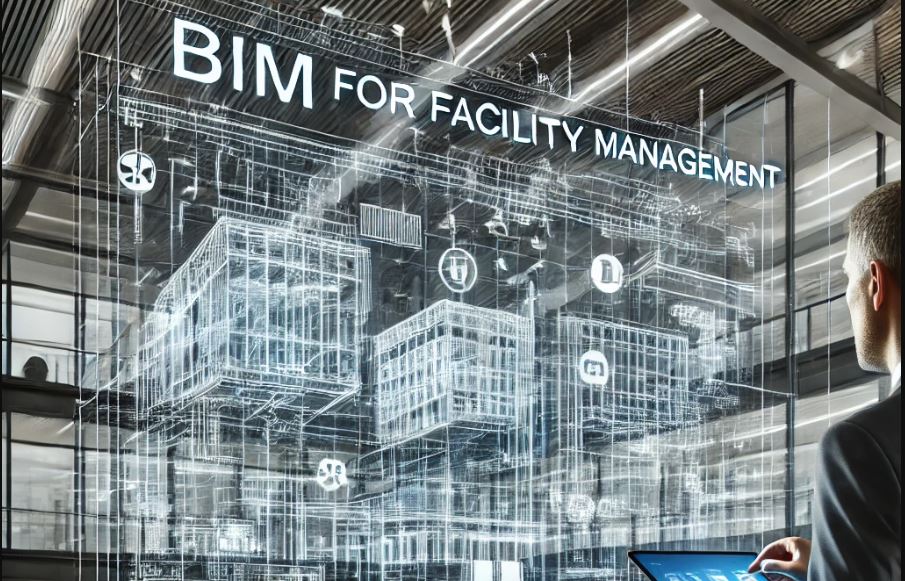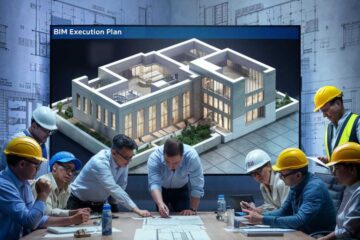BIM for Facility Management: Enhancing Efficiency and Effectiveness
Building Information Modeling (BIM) is revolutionizing the field of facility management by offering an advanced digital representation of a building’s physical and functional characteristics. This transformation allows facility managers to access real-time data, optimize operations, and enhance the overall efficiency of their facilities. The integration of BIM for facility management practices not only improves maintenance processes but also significantly reduces operational costs and environmental impact. This article delves into how BIM enhances facility management, supported by industry insights and practical examples.
Understanding BIM for Facility Management
What is BIM?
Building Information Modeling (BIM) is a comprehensive digital representation of a building’s physical and functional characteristics. It serves as a shared knowledge resource, forming a reliable basis for decision-making throughout the building’s life cycle. By integrating data from various sources, BIM provides a holistic view of the building’s structure, systems, and components, facilitating efficient management and maintenance.
Historical Context
The evolution of BIM from simple 2D drawings to complex 3D models and beyond has been significant. Initially adopted in design and construction, BIM now encompasses multiple dimensions, including time (4D), cost (5D), and sustainability (6D). Its adoption in facility management has been driven by the need to streamline operations, enhance data accessibility, and improve overall building performance. Over time, BIM has become an indispensable tool in the construction and facility management industries, providing detailed and accurate information that supports efficient building operations.
Components of BIM
The core components of BIM include Building Information Modeling, Model, and Management. These elements work together to create a detailed and dynamic model of the building. BIM integrates data from various sources, including architectural designs, structural analyses, and MEP (mechanical, electrical, and plumbing) systems. This comprehensive approach ensures that all aspects of the building are accurately represented and maintained throughout its life cycle.
The Operational Phase of Facility Management
Description
The operational phase of a building’s life cycle refers to the period during which the building is actively used and maintained. This phase is critical, as it encompasses routine maintenance, repairs, and renovations. Effective facility management during this phase ensures that the building remains functional, safe, and efficient. The operational phase also involves monitoring the building’s performance, managing energy consumption, and ensuring compliance with safety regulations.
Traditional vs. BIM Approach
Traditionally, facility management relied on paper-based documentation and manual processes. These methods often led to inefficiencies, data silos, and inaccurate information. In contrast, the adoption of BIM provides a centralized digital model that integrates all relevant information, making it easier to manage the facility efficiently. BIM enables real-time data access, predictive maintenance, and better decision-making. This shift from traditional methods to BIM-enabled facility management has significantly improved the way facilities are managed, leading to enhanced operational efficiency and reduced costs.
BIM can also help in identifying potential issues before they become critical, thus enabling proactive maintenance and reducing downtime. This approach not only improves the overall efficiency of the facility but also extends the life of building components, ensuring that the facility operates at its peak performance throughout its life cycle.
BIM for Facility Management: Enhancing Efficiency and Effectiveness
Benefits of BIM in Facility Management
Building Information Modeling (BIM) offers numerous benefits that enhance the efficiency and effectiveness of facility management. These benefits are realized through improved data centralization, enhanced lifecycle management, predictive maintenance, better collaboration, and significant cost efficiency.
Data Centralization
BIM centralizes data, providing a single source of truth for all facility-related information. This centralization ensures that all stakeholders have access to the same up-to-date data, reducing errors and enhancing decision-making. For example, facility managers can easily access information about the building’s systems and components, which simplifies maintenance and operations. The use of a centralized BIM model streamlines data management, making it easier to update and retrieve information as needed.
Lifecycle Management
BIM supports the entire lifecycle of a facility, from design and construction to operation and maintenance. This holistic approach ensures that all phases are interconnected, improving overall facility performance and sustainability. By integrating data from the initial design phase through to the operational phase, BIM provides a comprehensive view of the building’s lifecycle. This enables more effective planning and execution of maintenance activities, leading to reduced downtime and extended asset lifespans.
Predictive Maintenance
With BIM, facility managers can implement predictive maintenance strategies by analyzing data trends and identifying potential issues before they become critical. This proactive approach reduces downtime and maintenance costs. For instance, sensors integrated with the BIM system can monitor the performance of HVAC systems, identifying anomalies that may indicate impending failures. By addressing these issues early, facility managers can prevent costly breakdowns and ensure the continuous operation of critical building systems.
Enhanced Collaboration
BIM facilitates better collaboration among stakeholders by providing a shared platform for communication and data exchange. This enhanced collaboration leads to more efficient project management and improved outcomes. For example, architects, engineers, and facility managers can collaborate in real-time on the BIM platform, making it easier to coordinate efforts and resolve issues quickly. This collaborative approach ensures that all parties are aligned and working towards the same goals, leading to more successful projects and better-managed facilities.
Cost Efficiency
BIM helps in optimizing costs by providing accurate data for budgeting, forecasting, and resource allocation. The integration of BIM with facility management processes can lead to significant long-term cost savings. For example, BIM can be used to create detailed cost estimates for maintenance and renovation projects, ensuring that budgets are accurate and comprehensive. Additionally, by reducing the need for reactive maintenance and improving the efficiency of operations, BIM can help facilities achieve substantial cost savings over time.
Key Features and Tools of BIM for Facility Management
Digital Documentation
BIM replaces traditional paper-based documentation with digital models, making it easier to store, access, and update information. This transition to digital documentation ensures that all data is readily available and easily searchable, reducing the time and effort required to locate specific documents. For example, digital models can include detailed specifications, maintenance logs, and operational manuals, all accessible through the BIM platform.
Common Data Environment (CDE)
A Common Data Environment (CDE) enhances data accessibility and management by providing a centralized platform for storing and sharing information. The CDE serves as a collaborative workspace where all project stakeholders can access and update data in real-time. This ensures that everyone is working with the most current information, reducing errors and improving efficiency. For example, a CDE can streamline the coordination of maintenance activities, ensuring that all tasks are properly scheduled and executed.
Asset Information Model (AIM)
The transition from Project Information Model (PIM) to Asset Information Model (AIM) ensures that all relevant data is captured and maintained throughout the facility’s lifecycle. The AIM contains detailed information about each asset within the building, including specifications, maintenance history, and operational requirements. This comprehensive data set supports effective asset management and enables facility managers to optimize the performance of building systems. For example, the AIM can be used to track the condition of critical assets, ensuring that they are properly maintained and replaced as needed.
Integration with CAFM Software
Integrating BIM with Computer-Aided Facility Management (CAFM) systems enhances data management and operational efficiency. This integration enables real-time data exchange and better decision-making. For instance, integrating BIM with CAFM software allows for seamless communication between the digital model and the facility’s operational systems. This integration can streamline maintenance activities, improve space utilization, and optimize resource allocation.
Case Studies and Practical Examples
Case Study 1: Successful BIM Implementation
A detailed analysis of a successful BIM implementation in facility management highlights the benefits and best practices. For example, a large hospital successfully integrated BIM into its facility management processes, resulting in significant improvements in operational efficiency and maintenance outcomes. The hospital utilized BIM to centralize data, implement predictive maintenance, and enhance collaboration among stakeholders. This case study demonstrates how BIM can transform facility management in complex environments.
Case Study 2: Industry-Specific Example
An example focusing on a different industry, such as commercial real estate, demonstrates the versatility and effectiveness of BIM in various contexts. In this case, a commercial office building implemented BIM to improve space management, enhance energy efficiency, and reduce operational costs. The BIM model provided detailed information about the building’s systems and components, enabling more effective maintenance and operations. This example showcases the broad applicability of BIM across different sectors.
Lessons Learned
Key takeaways and best practices from the case studies provide valuable insights for facility managers considering BIM adoption. For instance, it is crucial to invest in proper training for staff, ensure the accuracy and completeness of the BIM model, and prioritize data integration across all systems. These lessons can help facility managers successfully implement BIM and realize its full potential in their facilities.
BIM for Facility Management: Enhancing Efficiency and Effectiveness
Overcoming Common Challenges
Despite the significant benefits of Building Information Modeling (BIM) in facility management, there are several challenges that need to be addressed to ensure successful implementation. Understanding and overcoming these challenges is crucial for facility managers to fully realize the potential of BIM.
Technical Barriers
One of the primary challenges in implementing BIM is the technical complexity involved. BIM requires sophisticated software and skilled personnel to create and manage the digital models. Additionally, the integration of BIM with existing facility management systems can be challenging due to compatibility issues. To overcome these barriers, it is essential to invest in training and development for staff, ensuring they are proficient in using BIM software such as Autodesk Revit and familiar with best practices in BIM management.
Furthermore, addressing interoperability issues is critical for seamless integration of BIM with other systems. The use of standardized file formats, such as COBie, can facilitate the transfer of information between different platforms, enhancing data exchange and reducing technical obstacles. Collaboration with software vendors and industry experts can also help in resolving technical challenges, ensuring a smooth transition to BIM-enabled facility management.
Data Management
Effective data management is another significant challenge in BIM implementation. The sheer volume of information generated by BIM can be overwhelming, making it difficult to maintain data accuracy and relevance. It is crucial to establish robust data governance practices to manage the data efficiently. This includes defining clear data standards, ensuring regular updates, and implementing quality control measures to maintain the integrity of the BIM model.
Additionally, leveraging a Common Data Environment (CDE)can streamline data management by providing a centralized platform for storing and sharing information. The CDE ensures that all stakeholders have access to accurate and up-to-date data, facilitating better decision-making and enhancing overall facility management. Implementing automated data validation tools can also help in maintaining data accuracy, reducing the risk of errors and inconsistencies.
Interoperability Issues
Interoperability issues can hinder the seamless integration of BIM with existing facility management systems. To address these issues, it is essential to adopt open standards and protocols that facilitate data exchange between different systems. The use of industry-standard file formats, such as COBie, can ensure compatibility and interoperability, enabling efficient data transfer and reducing the risk of information silos.
Collaboration with software vendors and industry experts can also help in resolving interoperability challenges. By working closely with these stakeholders, facility managers can identify and implement solutions that enhance the integration of BIM with other systems, ensuring a cohesive and efficient facility management process. Continuous monitoring and evaluation of the BIM implementation can help in identifying and addressing interoperability issues promptly, ensuring the system’s long-term success.
Future Trends in BIM for Facility Management
The future of BIM in facility management is shaped by several emerging trends and technological advancements. Understanding these trends can help facility managers stay ahead of the curve and leverage BIM to its fullest potential.
Technological Advancements
Technological advancements such as artificial intelligence (AI), the Internet of Things (IoT), and machine learning are set to revolutionize BIM in facility management. These technologies can enhance the capabilities of BIM, enabling more sophisticated analysis, predictive maintenance, and real-time monitoring of building systems. For example, AI algorithms can analyze vast amounts of data to identify patterns and predict potential issues, allowing for proactive maintenance and reducing downtime.
The integration of IoT devices with BIM can provide real-time data on building performance, energy consumption, and occupancy levels, enabling more efficient facility management. Machine learning algorithms can continuously learn from the data, improving the accuracy of predictions and enhancing decision-making. These technological advancements will play a crucial role in ensuring the long-term success of BIM in facility management.
Industry Adoption
The adoption of BIM in facility management is expected to grow significantly in the coming years. As more organizations recognize the benefits of BIM, its adoption will become more widespread, leading to improved facility management practices across various industries. Governments and regulatory bodies are also promoting the use of BIM by implementing standards and guidelines that encourage its adoption.
Additionally, the increasing focus on sustainability and energy efficiency is driving the adoption of BIM in facility management. By providing detailed information on building systems and energy consumption, BIM can help organizations achieve their sustainability goals and reduce their environmental impact. The continued growth of the BIM market and the increasing demand for sustainable building practices will further accelerate the adoption of BIM in facility management.
Sustainability
Sustainability is a key focus area for the future of BIM in facility management. BIM can play a crucial role in promoting sustainable building practices by providing detailed data on energy consumption, resource usage, and environmental impact. By leveraging this data, facility managers can implement strategies to reduce energy consumption, optimize resource use, and minimize waste.
For example, BIM can help in identifying opportunities for energy conservation and implementing energy-efficient technologies. The integration of BIM with energy management software can provide real-time data on energy usage, enabling facility managers to monitor and optimize energy consumption. This not only reduces operational costs but also contributes to a greener and more sustainable environment.
Conclusion
Recap
In summary, Building Information Modeling (BIM) offers significant benefits for facility management, including improved data centralization, enhanced lifecycle management, predictive maintenance, better collaboration, and significant cost efficiency. By addressing the technical barriers, data management challenges, and interoperability issues, organizations can successfully implement BIM and realize its full potential.
Call to Action
The integration of BIM into facility management practices is essential for organizations looking to enhance their operational efficiency and sustainability. Facility managers are encouraged to adopt BIM, invest in training and development, and collaborate with industry experts to overcome implementation challenges. By doing so, they can unlock the full potential of BIM and achieve significant improvements in their facility management processes.



